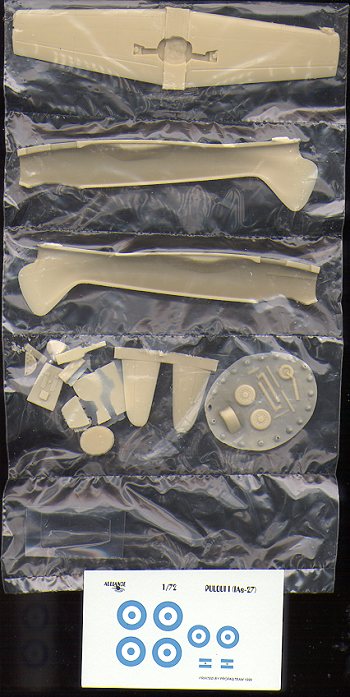
| KIT: | Alliance 1/72 Iae-27 Pulqui I |
| KIT # | 72010 |
| PRICE: | MSRP $36.98 |
| DECALS: | The prototype |
| REVIEW BY: | |
| NOTES: | Resin kit |

| HISTORY |
Having to quote from the instructions as I could find no reference for thisaircraft, "The first turbojet-powered aircraft built in Argentina. It wasdesigned as a single-seat interceptor. First flight of the one an only Pulqui Iwas made on 9 August, 1947, but it's performance was disappointing anddevelopment was discontinued."
| THE KIT |
 Allianceis a resin manufacturer from (surprise!) the Czech Republic. The kit comes in avery sturdy cardboard box, to protect the kit inside. Only wish that otherswould provide such protection though some padding would be nice as it is a bigbox for these parts to rattle around in. The packaging for this kit is veryreminiscent of Planet Models kits with all the bits in their own separatepockets.
Allianceis a resin manufacturer from (surprise!) the Czech Republic. The kit comes in avery sturdy cardboard box, to protect the kit inside. Only wish that otherswould provide such protection though some padding would be nice as it is a bigbox for these parts to rattle around in. The packaging for this kit is veryreminiscent of Planet Models kits with all the bits in their own separatepockets.
Molded in the typical light tan resin, the kit boasts of fine detailing andengraved panel lines (which will be eradicated with the first sanding). However,even a cursory inspection of the kit shows that this is where the similarity toPlanet Models kits ends. My example had big popped air bubble on the wing tip onone side (upper pocket), while on the other was a big blob of resin where thegate attached.
The fuselage halves also had this big blob near the tail and there are someholes where air bubbles popped on the rudder itself. These holes also appear onboth sided of the nose gear wheel fork, where it is near impossible to repair.All of the mating areas feel rough and will have to be sanded down prior to anyattempt to glue them together.
Before you accuse me of bashing this kit, let me just remind those who havenever built a resin kit, that rarely do you get one that has no faults orglitches like this. These situations are typical of the genre, and while the airbubbles can be minimized they cannot be totally eliminated.
The rest of the pieces are not that bad at all though all will have to be cutfrom blocks or removed from wafers. There is one vacuform canopy made of ratherthick plastic, which I like as it will make it easier to glue in place.
The decal sheet is by the ever-popular Propagteam and consists of Argentineroundels and tail flash. The instructions are also typical of Czech resin kits,consisting of a folded over sheet that makes four pages. The first is a briefhistory and parts breakdown, the next two a four step construction sequence andthe last page an exterior painting guide, though we the box art is really justabout as helpful.
Overall, it appears that this will be very much like most resin kits inconstruction. What makes this one a bit more difficult is the amount of damagecontrol that will have to be performed on several pieces. Not beyond the abilityof those who are at the resin kit stage, but not one I would foist on abeginner. Finding a place for nose weight will also be a challenge as this is adesign that looks to be quite a tail sitter.
It is not a large aircraft, and construction should be relativelystraightforward. Time will tell how well this kit builds. Stay tuned!
Review copy courtesy of me and my wallet!! If any of you manufacturersor shop owners want to send products for review and building, please contactme.
| CONSTRUCTION |
| PAINT & DECALS |
| CONCLUSIONS |
| REFERENCES |